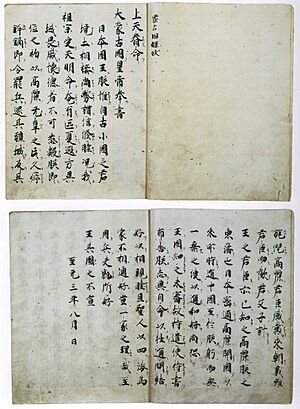Classical Chinese facts for kids
Quick facts for kids Classical Chinese |
||||
|---|---|---|---|---|
| Literary Chinese 古文 or 文言 |
||||
| Region | mainland China; Taiwan; Japan; Korea and Vietnam | |||
| Era | ca. 700 BC – 200 AD; continued as a literary language until the 20th century | |||
| Language family |
Sino-Tibetan
|
|||
| Writing system | Chinese | |||
|
||||
| Classical Chinese | |||||||||||||||||||||||
|---|---|---|---|---|---|---|---|---|---|---|---|---|---|---|---|---|---|---|---|---|---|---|---|
| Chinese name | |||||||||||||||||||||||
| Chinese | 古文 | ||||||||||||||||||||||
| Literal meaning | "ancient written language" | ||||||||||||||||||||||
|
|||||||||||||||||||||||
| Literary Chinese | |||||||||||||||||||||||
| Chinese | 文言 | ||||||||||||||||||||||
| Literal meaning | "literary language" | ||||||||||||||||||||||
|
|||||||||||||||||||||||
| Vietnamese name | |||||||||||||||||||||||
| Vietnamese | Hán văn | ||||||||||||||||||||||
Classical Chinese is a very old way of writing Chinese. It's like a special, formal style of writing that was used for a long, long time. This writing style is based on the grammar and vocabulary of ancient Chinese. Because of this, it sounds very different from how people speak Chinese today.
Classical Chinese was used for almost all official and formal writing. This was true in China until the early 1900s. It was also used in Korea, Japan, and Vietnam at different times in history.
Today, most Chinese speakers use a different writing style called written vernacular Chinese. This style is much closer to how people speak Mandarin Chinese every day. Also, people in Korea, Japan, and Vietnam now mostly use their own local languages for writing.
Even though many words in Classical Chinese have been replaced, you can still find many of its characters in modern Chinese words. These characters often keep their original meanings. For example, in Classical Chinese, "to eat" was 食 (shí). In modern Standard Chinese, it's 吃 (chī). But the character 食 is still used in words about food, like 食品 (shípĭn), which means "food."
Here's a table showing how some words changed:
| English word/phrase | Classical Chinese word (pinyin) | Standard Chinese word (pinyin) |
|---|---|---|
| "to not have/to lack" | 无/舞 (wǔ) | 没有 (měiyóu) |
| "to say" | 曰 (yuē) | 说/說 (shuō) |
| "teacher" | 先生 (xiānshēng) | 老师/老師 (lǎoshī) |
| "eye" | 目 (mù) | 眼睛 (yănjing) |
| "to drink" | 饮/飮 (yĭn) | 喝 (hē) |
Over many centuries, spoken Chinese changed a lot. It lost many sounds that were common in older dialects. This meant that many words in Classical Chinese started to sound too similar when spoken aloud. So, while you can read documents written in Classical Chinese, they can be very hard to understand if someone reads them out loud.
A great example of this is a type of poem called a "one-syllable article." In these poems, almost every word is pronounced with the same sound, but they have different meanings. Imagine trying to understand that when someone is speaking!
One famous poem is called 施氏食狮史 (Shī Shì Shí Shī Shǐ). In English, it's known as "The Lion-Eating Poet of the Stone Den." Every single word in the title is pronounced "shi," even though they have different tones. If you translated this title into modern Standard Chinese, it would sound like 施氏吃狮子的史诗 (Shī Shì chī shīzi de shǐshī). This shows how impractical Classical Chinese became as a spoken language.
Classical Chinese words are usually simpler. They are often made up of just one Chinese character. In contrast, most words in Standard Chinese use two to four characters. Writers in Classical Chinese tried to use as few characters as possible.
Here are some examples:
| English word/phrase | Classical Chinese word (pinyin) | Similar-sounding word (meaning) | Standard Chinese word (pinyin) |
|---|---|---|---|
| chopstick(s) | 筷 (kuài) | 快 (fast/quick) | 筷子 (kuàizi) |
| lion(s) | 狮/獅 (shī) | 诗/詩 (poem) | 狮子/獅子 (shīzi) |
| history/annals | 史 (shĭ) | 始 (begin/start) | 历史/歷史 (lìshĭ) |
| friend(s) | 朋 (péng) | 硼 (boron) | 朋友 (péngyǒu) |
| education | 教 (jiào) | 酵 (ferment/leaven) | 教育 (jiàoyù) |
Because Chinese sounds merged over time, extra characters were added to words in Standard Chinese. This helps to tell apart words that would otherwise sound exactly the same.
A famous phrase from Classical Chinese is Confucius's quote: 有教舞類 (yǒu jiào wǔ lèi). This roughly means, "In education, there should be no class distinction."
Modern use

Classical Chinese was the main way Chinese books and poems were written for a very long time. It was also widely used in Japan, Korea, and Vietnam.
In Taiwan, many government documents were written in Classical Chinese until the 1970s. Then, a change was made to switch to vernacular Chinese, which is closer to spoken language.
Today, pure Classical Chinese is sometimes used for very formal or special events. For example, the National Anthem of the Republic of China is in Classical Chinese. Also, old Buddhist texts, called sutras, are still kept in Classical Chinese. They were written or translated from Sanskrit a long time ago.
Most people today cannot write in full Classical Chinese easily. Only professional scholars and people who are very interested can do that. However, most Chinese people who have gone to middle school can read basic Classical Chinese. This is because learning to read it is part of the school curriculum in China. It's also part of the college entrance exam.
Images for kids
See also
 In Spanish: Chino clásico para niños
In Spanish: Chino clásico para niños


